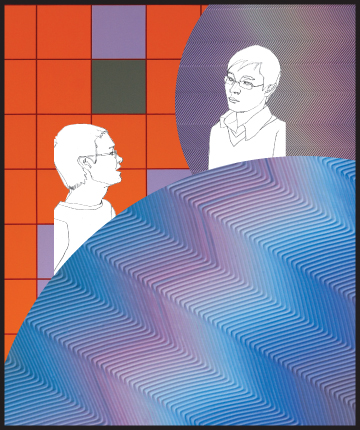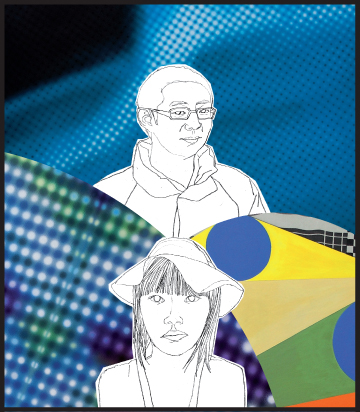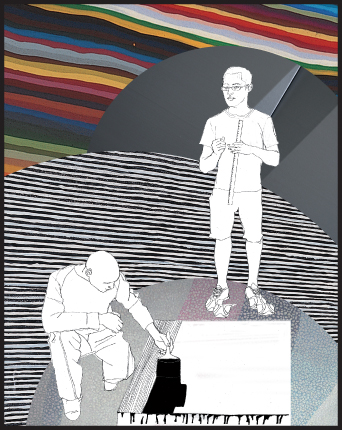INTERVIEWS: LIU WENTAO/WANG GUANGLE, XIE MOLIN/ZHAN RUI, LI SHURUI/ZHAO YAO
| February 14, 2012 | Post In LEAP 12
LIU WENTAO, WANG GUANGLE: SPACE AND TIME
LIU WENTAO
My early works consisted of piling layers of pencil lines on paper, gradually producing a highly compressed surface. Like looking at a flat plane of water, at a surface that gives no clues as to its actual depth, curiosity is aroused in the viewer who wants to penetrate the surface, under which is held a no clues as to its actual depth, curiosity is aroused in the viewer who wants to penetrate the surface, under which is held a notion of space. There could be a lot going on the surface, both sharp and soft pencil lines, though they’d be very delicately woven together to form a uniform shade. There’d be textural variations, both coarse and fine pencil lines, and variations in depth would be very subtle. As the lines completely dominate, lighter areas appearing on the canvas’s surface would be brought out. I would then focus my attention on the picture frame, towards granting its plasticity even more visual possibilities. At that time people were interpreting my work according to notions of temporality, whereas what I was actually looking at was the visual effect of the forming of pencil lines on a surface, in the space across the surface, or on the surface across the space.
Now my concerns have changed, as have the ways of addressing them. I now consider how notions of light and space can intervene in a piece. The lines on modifed frames aren’t that important anymore. If you look from a distance it is still a gray surface, but if you look closely, within the surface it is really complex; there are variations across layers, though from a distance it still has a visual quality. The pencil lines themselves, you could say, aren’t that important anymore: a lot of my recent works consist of a single base color applied directly onto a modified canvas, while the lines have disappeared and notions of light and space are accordingly emphasized.
In my latest show, the physical lines that emerged during the exhibition are the results of research into the space itself. Meanwhile, inessential elements of older works were discarded, for example certain textures on the canvas’s surface, maybe a base color, or a blue or a gray; I can now get around problems without having to spend as much time; if I just use pencil lines to form a composite gray it would get too monotonous. Interpretations of my work in relation to temporality is the work of others. I simply hope that people are able to calm down when they see my work, to be quiet and un-distracted, peaceful, even if just for a few seconds. If my work can do just this then I’m satisfied.
WANG GUANGLE
Actually when I was working on “Terrazo,” “Coffin Paint,” and “Untitled,” I didn’t distinguish much between them, though they developed a complementary relationship as I worked. “Terrazo” I could only work on there, so if I had to go home I’d work a bit on “Coffin Paint” and “Untitled,” I’d make use of all these little fragments of free time to work on them. For example, if today I’ve got lots of things to sort out, I’d paint for perhaps half an hour and then go out. It was all really impromptu, as if a question of survival.
Returning to formal issues: As an artist, what can you communicate to people with the formal techniques at your grasp? One of my principles is to try and express something using the least amount of formal elements possible. My latest exhibition at Beijing Commune (see review, LEAP 10) was no different, I was there, totally absorbed, applying paint layer by layer. Perhaps at the start not much progress seems to be being made, but in the end you stop thinking about the end result, as you know that it will emerge. You have to control the entire process, and regardless if you enjoy it or simply endure it, in the end the outcome will manifest itself. But of course this outcome has been designed, you are aware of the form it shall take from the very beginning.
So in terms of this dialectical relationship between process and outcome, I felt that if I stuck to a concept strictly, it would seem very systematic, without any doubt a fabrication. Originally that was because of time constraint, but later I thought that perhaps it didn’t need to be so systematic, so I incorporated a few different kinds of work to do at the same time.
I don’t consider space that much. However, I do feel that space and time are inseparable; space is the physical dimension in which time occurs. If an object is placed somewhere definite, we’d certainly discuss it in terms of space. But if you read a bit about physics, you discover that in fact things are placed in time, and once that period of time has passed, that thing will have gone. So I feel that maybe while time may affect Chinese people more strongly, space is a dimension yet to be fully explored.

XIE MOLIN, ZHAN RUI: LANGUAGE AND REASON
XIE MOLIN
Studying in the UK was for me quite liberating. In China, the majority of the teachers’ suggestions were about what you should paint, what you should study, what your generation should be like. But in British schools, the teaching method consists of telling you about the international art scene, giving you suggestions as to what you could contribute, what could still be done in art, where the strengths of your practice lay and how you differ from others. It was there that I think my primary artistic concerns changed.
I initially had no idea I’d end up making “abstract” works; I just wanted to make paintings of some sort. Up until about two years ago, my works had been somewhere between figurative and abstract, though later I realized that by eliminating imagery, I’d have a lot more freedom, and also a greater potential to achieve visual intensity. What I wanted to show was that an audience doesn’t need to interpret, that they can instead have an intense and totally new visual experience.
So, I became especially concerned with finding unique ways of making art, of painting. I experimented and slowly familiarized myself with propylene-based materials, then I started to use an engraving machine, and everything went from there. The engraving machine in particular has really sparked my imagination. In the six years that I’ve been using it, my own artistic methods and set of practices have gradually taken shape, which include using similar computer-controlled machines to produce two-dimensional works. I will possibly continue to create and use machinery as a means of seeking new methodologies.
My artistic methods are nowadays calm and rational. All my work is produced sequentially in a series of steps, each of these having first been carefully analyzed. If someone has a metaphysical or spiritual response to my work, perhaps it is a response to the sense of calm and order born out of my total process, one that actually completely relies on the transgression of human control.
ZHAN RUI
When I went to London, it became clear to me that there were far more forms and methods of producing art-works there than are known in China, so I abandoned the realist style I had learnt during my undergraduate degree pretty quickly. When I actually started to confront the idea of making new work, I wasn’t at all concerned with abstraction. I was paying much more attention to creating something that was different to anything traditional. In the end I chose to use the innumerable data found in daily life to construct my work, data that itself makes up the fundamentals of the quotidian. As for whether or not it can be called abstract, you could say that my method leads to the growth of an abstract outer shell or skin. And if it were to be counted as abstract, then it would be because I have established a relationship between abstract art and the stuff of daily life, thereby negating the traditional supposition that abstract art is primarily concerned with form (see review, LEAP 10).
I want to turn art into something totally real, to make every single part correspond to something real, rather than try and fabricate some grand, empty aesthetic explanation. For example, in “Weather” the subject matter is encoded within the 81 sections of the painting. The colors, form and arrangement of geometric shapes within the sections all have to follow the expression of the concept, rather than anything visual. With the subject matter in “Sex,” the level of visual control required was even greater. Not only did the blocks of color have to appear smooth, but the whole painting had to look like a monochrome— even though there were in fact two different levels of brightness being used. Such subtle differences are difficult to control manually, but just as much, they are based on the foundation of my expression of the quotidian; the evaluation is incredibly real. In making art, I like using this kind of rationale, as such manipulable methods suit my personality. So, even if I have produced a new concept, the mode of expression is still calm and balanced.

LI SHURUI, ZHAO YAO: BODY AND CONCEPT
LI SHURUI
There is no way I can speak about my two-dimensional works in isolation; they have to be considered in relation to my spatial installations. My creative process is guided by two key terms: light and space. These two elements are completely interdependent. In one sense they are objective entities that directly affect a person’s body, in another, they are the refection of or guides to a certain psychological condition.
The moment I saw the photographs of LED screens that I’d taken, I just wanted to paint them. It was a completely physiological reaction. The paintings came out accordingly, and I didn’t think about whether or not they were works of abstract art. My practice involves using the physical space of the painting to draw the viewer in, to produce a compelling spatio-visual experience to totally envelop the viewer. The viewer’s field of vision is completely dominated, allowing them to be immersed, momentarily let go of their empirical logical faculties, and allow their physical and psychological responses to become one. I don’t want my audience’s understanding of my work to be guided by textual interpretation, in fact I want to completely remove this obstructive aspect. I don’t want excessive interpretation to cause the audience to look straight through the work.
When conceptual art took of in China, it brought with it a side-effect: the moment you did something you had to explain it, you had to provide people with a set of clues. This way of doing things is in fact extremely reductive, as the text imposes great limitations on the work. For example, neither an explanation in Chinese or English would ever approach anything comprehensive, and if you try to explain a piece of work using imported terms or philosophical concepts, mistranslations and jargon will render the text all the more unclear. Ideally, I want my work to bloom out of physical and sensory experience, to transcend interpretation.
ZHAO YAO
I’ve always considered my work to be conceptual. A lot of the time it is made in response to a specific concept or accepted notion within contemporary art. The most representative of this approach is the series “A Painting of Thought,” wherein the images are taken from brain-teaser puzzles, and the canvas is actually geometrically patterned fabric. My paintings are not at all an attack of abstract painting; the intention is simply to stimulate the audience’s understanding of abstract painting, their comprehension of the legitimacy of a painting (see review, LEAP 10).
So-called aesthetic liberation in art is in actuality political liberation, as aesthetics carries within it many ideological decisions. This ought not to take the form of piling up various rational formulations, but rather should produce a kind of chemical reaction between them. Like when the brain-teaser puzzles were added onto the ready-made fabric in my paintings, two opposing forms came together and produced the possibility of a new understanding.
I think that when discussing conceptual art, only when the concept is understood as form can you be sure that the two won’t obstruct or intrude on each other. In reality, if a concept is pure then it has already become form, so I think that regardless of what the concept or the idea behind the work is like, it must still ultimately return to its form. Form nowadays is more like a kind of action, a practice that has developed out of thought and refection. It no longer lies within a purely visual or aesthetic realm. I think that in the future form will evolve into something born of action.
If you find a certain way to make someone experience something, this will produce a new kind of understanding. I once read a commentary on a line of a classical poem, “On branch tips the hibiscus…” (Wang Wei). It said that when you hear the poem and like it, you imagine that it’ll read well on paper too. But when you come to write out the characters, you see how they actually resemble the form of hibiscus flowers: the line begins with a simple character, is then followed by another more complex, the third and the fourth more elaborate proportionally. The line actually visualizes a hibiscus in bloom, from stalk to flower. So if you want to appreciate this poem’s artistry, write it out and it’ll be even better. Sometimes it’s the same with art: to hear a line spoken and to read it yourself are two quite different experiences.


